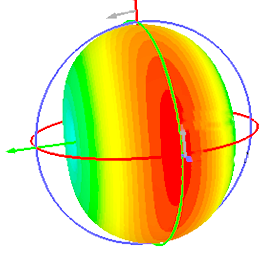On miniaturization of efficient ultra-wideband printed quazi-Yagi antenna array for indoor applications
DOI:
https://doi.org/10.3103/S0735272717060024Keywords:
compact, ultra-wideband, unidirectionale, indoor communications, bandwidth, gain, sidelobe level, arraysAbstract
This paper describes the design and analysis of a compact and efficient ultra-wideband unidirectional printed Array antenna for indoor applications. A 12.2´6.3´1 cm array antenna is capable of covering an ultra-wide frequency band starting from LTE up to Wi-MAX with an average gain approaching 5 dBi over the entire bandwidth. In comparison with the already existing antenna systems in the wireless market for similar purposes, the proposed antenna has considerably shown better performance and supplementary compactness which makes it competitive among other antenna models. Simulation results have also shown low cross polarization levels, where the sidelobe level was also minimized by introducing special reflecting element in the designed model. Adopting the proposed antenna in indoor communication systems would surely enhance the quality of signal within the covered area as well as minimize the number of access points needed for a given network.References
- SAUNDERS, SIMON R. Antennas and Propagation for Wireless Communication Systems. England: Wiley, 1999.
- BALANIS, C.A. Antenna Theory: Analysis and Design, 3rd ed. New Jersey: John Wiley & Sons, Inc., 2005.
- ELSHERBENI, A.Z.; ELDEK, A.A.; SMITH, C.E. Wideband slot and printed antennas. Encyclopedia of RF and Microwave Engineering (ed. by K. Change). John Wiley, Jan. 2005.
- QIAN, Y.; DEAL, W.R.; KANEDA, N.; ITOH, T. Microstrip-fed quasi-Yagi antenna with broadband characteristics. Electron. Lett., v.34, n.23, p.2194-2196, 1998. doi:http://dx.doi.org/10.1049/el:19981583.
- ELDEK, A.A.; ELSHERBENI, A.Z.; SMITH, C.E. Wideband microstrip-fed printed bow-tie antenna for phased-array systems. Microwave Opt. Tech. Lett., v.43, n.2, p.123-126, 2004. doi:http://dx.doi.org/10.1002/mop.20396.
- FLOC’H, J.M.; AHMAD, A. EL SAYED. Broadband quasi-Yagi antenna for WiFi and WiMax applications. Wireless Engineering and Technology, v.4, n.2, p.87-91, 2013. doi:http://dx.doi.org/10.4236/wet.2013.42013.
- HARRINGTON, R.F. Effect of antenna size on gain, bandwidth, and efficiency. J. Research of the National Bureau Standards. Section D: Radio Propagation, v.64-D, n.1, p.1-12, 1960. doi:http://dx.doi.org/10.6028/jres.064D.003.
- CHU, L.J. Physical limitations of omni-directional antennas. J. Appl. Phys., v.19, n.12, p.1163-1175, 1948. doi:http://doi.org/10.1063/1.1715038.
- WHEELER, H.A. Fundamental limitations of small antennas. Proc. IRE, v.35, n.12, p.1479-1484, 1947. doi:http://dx.doi.org/10.1109/JRPROC.1947.226199.

Downloads
Published
2017-06-30
Issue
Section
Research Articles

